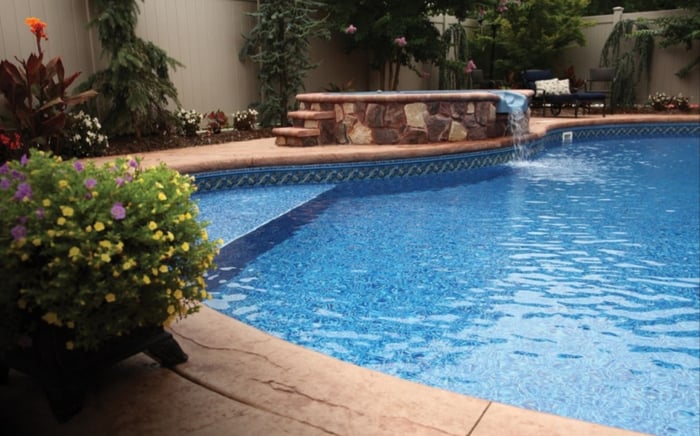Proper swimming pool maintenance is important as it helps your swimming pool to have a longer lifespan, as well as ensures that the water is clean and safe to swim all the time.
One of the main components of proper pool maintenance is your filtration system. The filter system eliminates the small particles in the water including dirt and contaminants and should operate for about 8 – 12 hours per day. By filtering the water in the pool, significantly less contaminant build up will occur, and if you don’t install the filtration system, the water will be dirty and unsafe to swim in.
What's Wrong with Dirty Water?
Dirty water encourages the growth of the algae, as well as other contaminants that can be harmful to not only your pool, but to your swimmers as well.
You can lengthen the life of the filtration system by adding sand or diatomaceous earth. You must frequently clean the filer so that oils and dirty particles can be removed from the filter.
Finding the right pH Balance
The swimming pool must have the water balance of acidity vs. alkalinity, commonly referred to as pH balance. The pH of the water can change after a period of time because of chemical treatments and the use of a filtration system. To ensure the water has the right pH, you must check the hardness, alkalinity and pH balance. The most common way to test pH is with 3-1 test strips, which should be used to check the pH balance of the water once or twice a week.
The pH of the swimming pool water can range from 0 – 14. You should maintain the pH range of the water between 7 – 8. If your swimming pool is made from vinyl, the pH range of the water should be 7.6. If the pH readings of the water is 7.8, the water will become cloudy, as well as cause your swimmers to feel uncomfortable when swimming in it. If the pH reading is lower than 7.2, the swimming pool is subject to corrosion problems.
Hardness and Mineral Content
In addition to pH, you should also pay close attention to the hardness of your pool's water. The hardness refers to the amount of calcium and magnesium in the water. Soft water has a hardness level of 50 ppm. Hard water has a hardness of 300 ppm. For plaster pools, the average water hardness is 200 – 250 ppm. If the swimming pool is made from fiberglass, the water hardness should be between 175 – 225 ppm. The recommended hardness for water in vinyl liner pools is between 150-200 ppm.
To ensure proper pool maintenance, mineral content is another variable that must be kept under control, particularly the levels of iron and copper content. If the water has a high level of iron and copper, the water will suffer from discoloration and become stained. When the water suffers from discoloration, it will change to other colors such as green, brown and black.
Water Sanitation
Lastly, you will want to make sure your pool water must is stabilized and sanitized. The most common way of doing this is through chlorine, of which there are several types. The economical chlorine is cheaper and comes in sticks or tablets form and can be applied to the water every week. The chlorine sticks will not be affected by the sunlight. When applying the chlorine, make sure it remain on a level of 1 – 2 pp, so that all the germs can be killed.
But beyond simply adding chemicals to your pool, there are quite a few other ways you can keep your pool in top condition. Following these tips will not only make ongoing maintenance easier and help your pool last longer, but will also assist in making your pool more enjoyable for you and your guests.
10 Tips for Proper Pool Maintenance
- Skimming the surface of the pool for floating debris and emptying the skimmer basket takes just a minute or two. Dispose of this waste away from the pool so it can't blow back into the water or be tracked back into the area.
- Direct return jet eyeballs downward to quiet surface ripples. This will allow you to see the pool bottom clearly.
- Begin cleaning by brushing any buildup off the pool walls with a nylon brush on the vacuum pole. For concrete pools, use a stainless steel brush.
- After brushing, remove the brush attachment and connect the vacuum head and vacuum hose to the pole. Then, prop up the pole with the vacuum head suspended over the water. Use one of the return jets to fill the free hose end until the water pours out of the vacuum.
- When full, submerge the vacuum head and clamp your hand over the hose until you connect the hose to the skimmer.
- The average pool requires 30 minutes of vacuuming. Vacuum slowly across the water in overlapping parallel lines, like mowing a lawn or vacuuming your carpet.
- If the pool is too wide for one pass across, vacuum one half at a time.
- Watch out for a floating hose, which indicates a hole in the line, or diminished suction due to a full filter.
- Test and correct pool chemistry weekly. Adjust pH first—with muriatic acid if pH is above 7.6 or with a soda ash product if pH is under 7.4.
- If the chlorine is below 1 part per million (ppm) "shock" the water. To shock the water, dissolve chlorine in a bucket of water and pour it into the pool.
You can also check out our additional DIY maintenance resources below:
- Finally! An Easy Solution to Pool Maintenance
- How to Clean and Maintain Your Own Swimming Pool
- How to clear a murky green pool fast with Revive
- Make keeping your pool clean and clear easy with E-Z Pool
- The perfect solution for your saltwater pool: Pepper!
- Pool opening supply buyer's guide
- How to identify and treat pool algae
- Saltwater Above Ground Pools: A Buyer’s Guide
- Money-Saving Pool Hack: Use Baking Soda to Raise Alkalinity Levels




